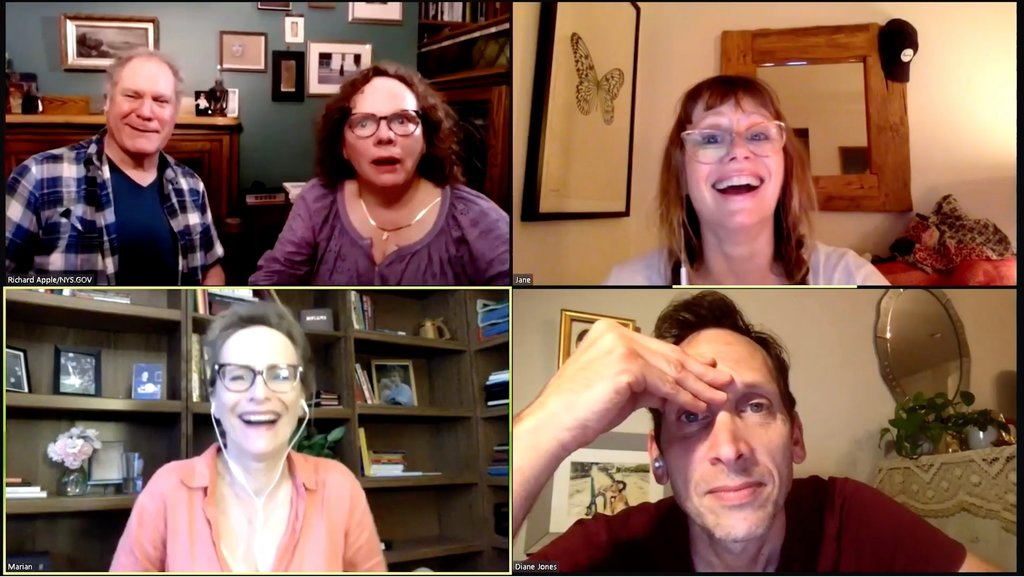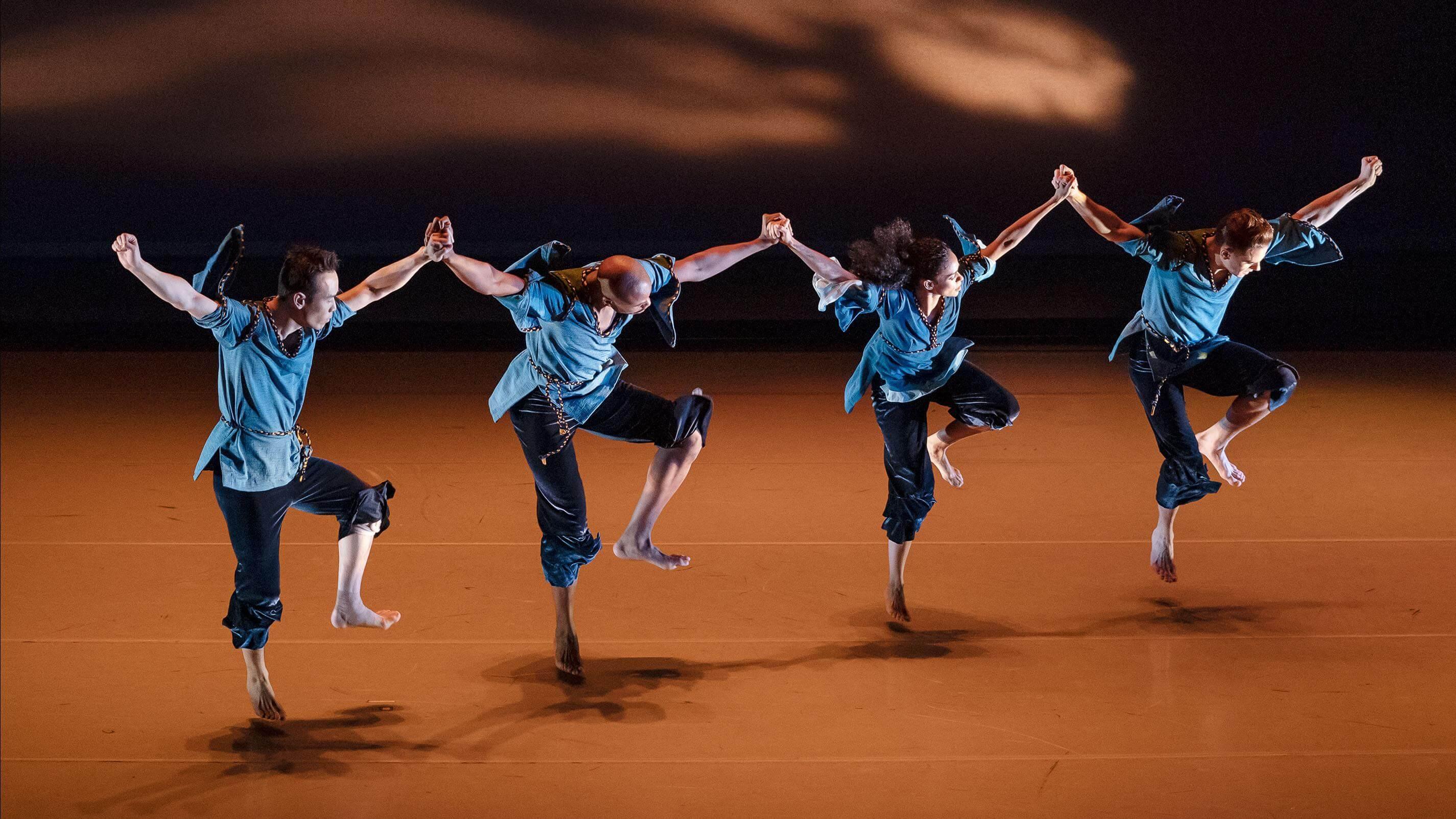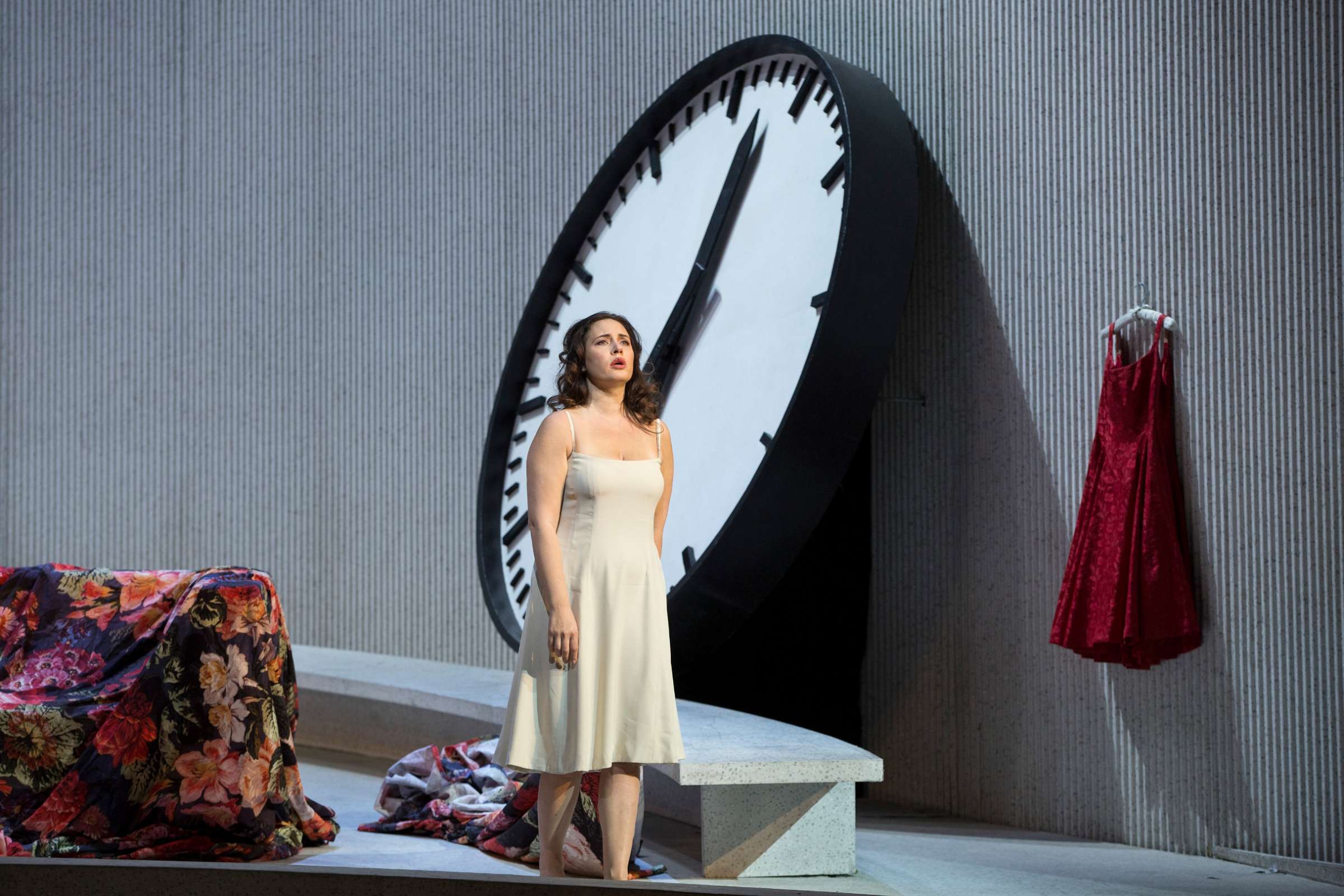VIEWPOINTS – Streaming Diary: The Apple Family saga continues in Zoom, a deeper dive into the Alvin Ailey repertoire, and Met productions of LA TRAVIATA over the years
- By drediman
- July 19, 2020
- No Comments
Here’s a roundup of my thoughts from the week past (write-ups on Shakespeare on the Radio’s timely Richard II and the final three episodes of Playwrights Horizons’ excellent Soundstage series can be found in my previous post). Also, some have asked me for a good resource for listings of performing arts content that’s available for streaming on the Internet. I’ve invariably pointed them to Adam Feldman’s indispensable, regularly-updated guide, which you can access by going to Time Out New York’s website.

Jay O. Sanders, Maryann Plunkett, Sally Murphy, Stephen Kunken, and Laila Robins in “And So We Come Forth” by Richard Nelson.
THEATER
The penultimate offering of NT at Home’s programming was last week’s webcast of Terrence Rattigan’s 1952 domestic drama The Deep Blue Sea (HIGHLY RECOMMENDED). The play was revived to great acclaim in 2016 by London’s National Theatre, and it’s this production that was captured on film via NT Live. In the central role of Hester Collyer was Helen McCrory, whose outstanding performance skillfully exposed the character’s conflicted psyche. Indeed, Ms. McCrory’s anxiety-ridden, carefully calibrated performance brilliantly illuminated the dynamic layers underlying the veneer of the modern woman. The other cast members gave confident, nuanced performances, especially Peter Sullivan and Tom Burke as the two men tugging for Hester’s affection. Even from my computer screen, I could tell that the production by Carrie Cracknell (whose work stateside in A Doll’s House at BAM and Sea Wall/A Life at the Public and on Broadway I greatly admired) oozed atmosphere and tension.
Just this past April, Richard Nelson gave us What Do We Need to Talk About?, the fifth installment (after a lengthy hiatus) of the playwright’s celebrated Apple Family Plays and one of the few completely successful Zoom-based plays produced so far during the pandemic era. Much of its success, in addition to Mr. Nelson’s comforting, deceptively laid back style, lied in presenting the play as an actual Zoom call, thereby turning the physical limitations of the technology into a dramaturgical necessity.
In light of the dizzying evolution of the world order since the play was webcast just a few months ago, Mr. Nelson has written an immediate sequel – still in Zooming mode – entitled And So We Come Forth (HIGHLY RECOMMENDED), which I recently had the pleasure of streaming. Happily, it’s a welcome – albeit quietly devastating – addition to Mr. Nelson’s intimate saga. Over the years across a multitude of plays, I’ve gotten to know the members of the Apple family quite intimately. This kind of familiarity is typically reserved for characters on television and is a rare occurrence in the theater, where efficient plotting and character development are usually considered virtues. This sixth installment finds the middle-aged siblings (who continue to be flawlessly played by the same set of actors who have played them since the first play of the series, That Hopey Changey Thing, which premiered a decade ago) slowly losing touch with an unsparing society that’s relentlessly plowing forward. As in the previous plays, the final image of Barbara, played with gut-wrenching fortitude by the incomparable Maryann Plunkett, gently broke my heart. My only suggestion — let’s get these last two plays performed *live* (in repertoire?) on Zoom for a proper run. I would pay to see that.

Robert Battle’s “Juba” danced by Alvin Ailey American Dance Theater.
DANCE
Last week, I got to spend some more time acquainting myself with Alvin Ailey American Dance Theater’s repertoire of dances. First up for me was artistic director Robert Battle’s 2003 Juba (RECOMMENDED), which seems to be overtly inspired by the game-changing ballet The Rite of Spring. With its driving rhythms and vibrant colors, the score by John Mackey unsurprisingly mirrors Igor Stravinsky’s score for the 1913 ballet, although it lacks that groundbreaking musical composition’s variety and narrative purposing. As for the choreography, Mr. Battle has embraced the rhythmic qualities of Mr. Mackey’s percussive score, creating a work that’s exciting to watch for its bold, thumping repetitions and eye-catchingly athletic homage to what looks like Russian folk dancing. I suspect it was a conscious decision to replace the underlying ballet’s storyline (the portrayal of the sacrifice of a young girl to invoke the arrival of spring) for a more abstract presentation. Still, The Rite of Spring‘s tribalism and brutal ritualistic practices pervade the essence of Mr. Battle’s work. The piece features four dancers – three men and one woman – a ratio which once again vaguely calls to mind the premise of Rite.
Then I took in Camille A. Brown’s 2010 City of Rain (RECOMMENDED), a dance whose creation was triggered by the death of a fellow dancer who was debilitated during his life. In recent seasons, I’ve taken note of Ms. Brown’s invaluable choreographic contributions across various performing arts genres (she provided the dances for the Public’s stunning revival of Ntozake Shange’s seminal “choreopoem” For Colored Girls Who Have Considered Suicide / When the Rainbow Is Enuf and the Metropolitan Opera’s commercially successful new production of the Gershwins’ Porgy and Bess). As befits its inspiration, City of Rain is a work that’s somber yet infused with dignity. I appreciated its fluidity and grace, as well as its attention to gestural details. But most of all, I admired Ms. Brown’s ability to vividly convey human emotion through her choreography (a quality shared by iconic Israeli choreographer Ohad Naharin), as opposed to staging movement simply for movement’s sake. It’s this uncannily theatrical talent which I think has contributed to the increased demand for her work beyond the world of dance. She’s definitely a dance-maker to look out for.

Sonya Yoncheva in the Metropolitan Opera’s (former) production of Verdi’s “La Traviata”.
OPERA
Particularly for opera lovers like myself, one of the great pleasures of the Metropolitan Opera’s Nighty Opera Streams programming during the pandemic has been getting the chance to see and compare multiple productions of the same opera over the years in relatively close succession. A case in point was the opportunity to contrast last week’s streaming of a 1981 performance of Verdi’s beloved La Traviata — starring opera legends Ileana Cotrubas and Placido Domingo as Violetta and Alfredo, respectively, in a determinedly realistic production by director Colin Graham — with subsequent stagings. One of those was a 2017 performance of Willy Decker’s strikingly abstract production, featuring plush-voiced Belgian soprano Sonya Yoncheva as the ailing courtesan (Violetta) and dashing American tenor Michael Fabiano (Alfredo) as her passionate suitor. Additionally, I believe in the first week of the Met’s generous nightly streaming, I watched Michael Mayer’s current production, which premiered in 2018 with two fan favorites, vibrant German soprano Diana Damrau and the virtuostic tenor Juan Diego Flórez.
The “winner” in terms of staging? Well, despite Mr. Mayer’s valiant effort to merge the realism of Mr. Graham’s staging with an appealing impressionistic sensibility, my pick goes to Mr. Decker’s sensationally surreal production (HIGHLY RECOMMENDED) (which Mr. Mayer’s production replaced) for its aesthetic daring, which in my book paid off in spades by heightening the opera’s sense of urgency (a oversized clock, signifying Violetta’s impending mortality, is a key aspect of the design). Suffice to say, I miss Mr. Decker’s production terribly.
Speaking of directors who have successfully painted the Met’s huge canvas with their uncompromising vision, I think few would argue that South African artist William Kentridge belongs on the list. Completing Mr. Kentridge’s triptych of productions at the Met – following well-received productions of Shostakovich’s The Nose and Berg’s Lulu – was last winter’s staging of Wozzeck (RECOMMENDED), another Berg opera (all three Kentridge productions found their way onto the Met’s Nightly Opera Streams). The opera, which is based on a pre-expressionistic 1913 play by Georg Büchner, tells the story of an unremarkable soldier and his oppressive treatment at the hands of society (including his unfaithful wife). Despite its running time of approximately 90 minutes – brief by opera standards – the work is a disturbing experience, which is emphasized by Mr. Kentridge’s disorienting staging. Indeed, the artist’s trademark visual cacophony is an inspired match for the dissonance of Berg’s difficult score. The forceful bombardment of the production didn’t stop there; in the title role, stylish Swedish baritone all but disappeared into the role, giving a dramatically intense performance, and maestro Yannick Nézet-Séguin led an astute reading of the atonal score.

 Copyright © 2025
Copyright © 2025
Leave a Reply